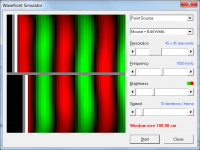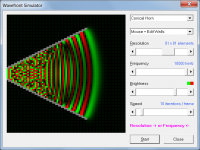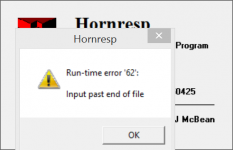Hi PB,
It would require some work, but I can't see why it should not be possible to arrange for multiple drivers to have different phasings, as shown in the attached example. The lower driver is delayed by 0.26 msec, equivalent to a distance of 8.94 cm.
Sanity check:
1 grid unit = window width / elements = 100 / 45 = 4.22 cm
The offset distance between the drivers is 4 grid units or 8.89 cm
The outputs from the two drivers are effectively in phase, as expected. The slight differences are due to the actual offset distance not being equal to the exact theoretical length.
I am not sure how useful the feature would be in practice though . Offset distances can only be set to the nearest grid point, limiting the degree of precision. Given the constraint, is worth pursuing the development of this feature? If so, would a maximum allowable delay of 1 msec be sufficient, equivalent to an offset distance of 34.4 cm?
. Offset distances can only be set to the nearest grid point, limiting the degree of precision. Given the constraint, is worth pursuing the development of this feature? If so, would a maximum allowable delay of 1 msec be sufficient, equivalent to an offset distance of 34.4 cm?
Kind regards,
David
Out of curiosity, how hard would it be to implement a delay parameter in the wave tank simulator?
It would require some work, but I can't see why it should not be possible to arrange for multiple drivers to have different phasings, as shown in the attached example. The lower driver is delayed by 0.26 msec, equivalent to a distance of 8.94 cm.
Sanity check:
1 grid unit = window width / elements = 100 / 45 = 4.22 cm
The offset distance between the drivers is 4 grid units or 8.89 cm
The outputs from the two drivers are effectively in phase, as expected. The slight differences are due to the actual offset distance not being equal to the exact theoretical length.
For instance, if you have two woofers in the sim, you delay one woofer by one millisecond so that the output of the woofer is aligned with a second woofer that's 34cm behind the first. The one millisecond delay aligns their wavefronts and creates a cardioid response.
I am not sure how useful the feature would be in practice though
Kind regards,
David
Attachments
Offset distances can only be set to the nearest grid point, limiting the degree of precision.
Maybe it would be okay if a higher resolution is used, eg 135 x 135 elements?
Correction
I just noticed a typographical error in Post #5902.
Should read:
1 grid unit = window width / elements = 100 / 45 = 2.22 cm
I just noticed a typographical error in Post #5902.
1 grid unit = window width / elements = 100 / 45 = 4.22 cm
Should read:
1 grid unit = window width / elements = 100 / 45 = 2.22 cm
Is the "dimension" minimum(2.22 cm) in the ripple tank simulation a constraint on the upper frequency limit it is possible to accurately simulate?
Hi Mark,
The upper frequency limit that can be accurately simulated before aliasing effects start to impact on the results depends upon the sampling rate, the resolution setting and the window size.
The guidance message "Resolution -> or Frequency <-" is displayed when the upper frequency limit is exceeded.
The attached screenprint shows the effect of aliasing (very obvious in the first half of the example horn).
Kind regards,
David
Attachments
Offset distances can only be set to the nearest grid point, limiting the degree of precision. Given the constraint, is worth pursuing the development of this feature? If so, would a maximum allowable delay of 1 msec be sufficient, equivalent to an offset distance of 34.4 cm?
Still awaiting a response from 'Patrick Bateman'...
Development of the delay feature requires a reasonable amount of work, and I would like to be reassured that it is worth undertaking before committing to it
Still awaiting a response from 'Patrick Bateman'....
Development of the delay feature requires a reasonable amount of work, and I would like to be reassured that it is worth undertaking before committing to it.
That would allow simulating a push-pull type of a horn. Or for that matter an enclosure.
I think that is a worthy cause.
Danley's sub ideas could be simulated. At least a little more accurately.
Thanks for the clarification on the ripple tank simulations.
After I posted the question I started to think that it would also be linked to the cycle speed and probably a sample rate of some kind. But I was not certain on that idea.
Now a separate question.
The multiple input horn simulation. The synergy type simulation.
Does it get modeled as a lumped plain wave?
Or does it get modeled as a set of different plain waves?
Still awaiting a response from 'Patrick Bateman'....
Development of the delay feature requires a reasonable amount of work, and I would like to be reassured that it is worth undertaking before committing to it.
How long do you think it would take?
I spent about three days trying to do it myself here, in html5:
Car Audio | DiyMobileAudio.com | Car Stereo Forum - View Single Post - Crazy Wide Soundstage
For me, it's useful for a couple things:
1) end fire arrays
2) compound horns where we use delay on one woofer to widen the bandwidth
But I'd hate to see you spend three days on it, not sure how much work it is to add a delay parameter
You should set up a paypal option
The multiple input horn simulation. The synergy type simulation.
Does it get modeled as a lumped plain wave?
Or does it get modeled as a set of different plain waves?
Hi Mark,
The multiple mid-frequency drivers are modelled as a single composite driver. Similarly, multiple low-frequency drivers are modelled as a single composite driver.
As far as the overall system is concerned, it is probably better to think of the simulation model in terms of volume velocity and pressure, rather than waves. The model calculates the resultant volume velocity and pressure at the horn mouth due to the multiple driver inputs. Because the acoustical impedance at the mouth is known, the output power can be determined.
Pressures and volume velocities through the individual horn segments making up the system are calculated using a plane wavefront model.
Kind regards,
David
just got this error, anythoughts (on startup).
Hi sine143,
It would seem that your Hornresp.dat file has been corrupted in some way. This is most unusual.
If the data is important to you I may be able to fix the file, if you care to send me a copy.
The Hornresp.dat file is located in the 'Data' sub-folder under the folder in which you have placed the Hornresp.exe application file.
Click on my name on the Hornresp download web page for my email address.
If the old data is not critical, simply deleted your existing Hornresp.dat file and a new one will be automatically created when you next start Hornresp.
Kind regards,
David
How long do you think it would take?
I spent about three days trying to do it myself here, in html5:
Car Audio | DiyMobileAudio.com | Car Stereo Forum - View Single Post - Crazy Wide Soundstage
For me, it's useful for a couple things:
1) end fire arrays
2) compound horns where we use delay on one woofer to widen the bandwidth
But I'd hate to see you spend three days on it, not sure how much work it is to add a delay parameter
You should set up a paypal option
Hi PB,
Thanks for responding.
Getting the actual delay feature to work is the easy part - it was necessary to do this to produce the results shown in Post #5902
What takes the time is building a practical user interface. It needs to be robust but not too difficult to use. I have been thinking about it, and believe that I may have a workable solution, but I suspect that it will take more than three days to code and test.
Three days is nothing when it comes to time spent on Hornresp development...
Hopefully the delay feature will be included in the next update.
Kind regards,
David
After about a year of watching Hornresp threads, I thought that I would take the plunge and download Hornresp, but after downloading the program, when I hit Hornresp.exe my Norton antivirus quarantined the file.
Norton did the same to the update to my Freemake video download freeware.
Norton did the same to the update to my Freemake video download freeware.
after downloading the program, when I hit Hornresp.exe my Norton antivirus quarantined the file.
Hi VolvoHeretic,
Your antivirus software is being over-zealous, it is registering a false positive.
Nothing to worry about, Hornresp is quite safe to use
Kind regards,
David
Attachments
Thanks GM and Davin McBean, I will report back in a couple of months. I can see that this will be a steep learning curve.  I am reading the tutorial; Hornresp for Dum... hmm... Everyone
I am reading the tutorial; Hornresp for Dum... hmm... Everyone 
http://www.hometheatershack.com/for...scussion/36532-hornresp-dum-hmm-everyone.html
http://www.hometheatershack.com/for...scussion/36532-hornresp-dum-hmm-everyone.html
Last edited:
- Home
- Loudspeakers
- Subwoofers
- Hornresp



